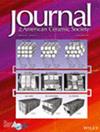Bi4Ti3O12-BiFeO3 体系中 Aurivillius 化合物的形成动力学和热力学稳定性
IF 3.5
3区 材料科学
Q1 MATERIALS SCIENCE, CERAMICS
引用次数: 0
摘要
Bi2O3-Fe2O3-TiO2 系统中的 Aurivillius 化合物集铁电、半导体和铁磁特性于一身,引起了人们的特别关注。形成动力学和热力学稳定性是建模和预测材料加工过程中微观结构和性能演变的基本知识,但尚未通过定量实验测量来解决这一问题。本文以 Bi4Ti3O12-BiFeO3 连接线上的 Bin+1Fen-3Ti3O3n+3 Aurivillius 化合物为研究对象,阐明了具有各种类包晶层的化合物相形成的机理和热力学控制。合成了五种高纯度奥里维利乌斯化合物 Bi4Ti3O12、Bi5FeTi3O15、Bi6Fe2Ti3O18、Bi7Fe3Ti3O21 和 Bi8Fe4Ti3O24(n=3-7),并通过 X 射线原位衍射、高温差示扫描量热法和高温氧化物熔解量热法研究了它们的相变性质和形成焓。这些化合物的热力学稳定性随着 n 的增大而降低,形成动力学也逐渐减慢,这表明很难合成出 n 大于 8 的纯 Aurivillius 化合物。本文章由计算机程序翻译,如有差异,请以英文原文为准。
Formation kinetics and thermodynamic stability of the Aurivillius compounds in Bi4Ti3O12–BiFeO3 system
The Aurivillius compounds in the Bi2 O3 –Fe2 O3 –TiO2 system, combining ferroelectric, semiconducting, and ferromagnetic properties, have attracted particular interest. Formation kinetics and thermodynamic stability are the fundamental knowledge needed for modeling and predicting the temporal microstructure and property evolution during materials processing but have not yet been addressed by quantitative experimental measurement. This article focuses on the Bin +1 Fen –3 Ti3 O3 n +3 Aurivillius compounds on the Bi4 Ti3 O12 –BiFeO3 tie‐line to elucidate the mechanisms and thermodynamic controls responsible for phase formation of compounds with various perovskite‐like layers. Five high‐purity Aurivillius compounds Bi4 Ti3 O12 , Bi5 FeTi3 O15 , Bi6 Fe2 Ti3 O18 , Bi7 Fe3 Ti3 O21 , and Bi8 Fe4 Ti3 O24 with integer n = 3–7 values were synthesized and their phase transformation properties and enthalpies of formation were studied by X‐ray diffraction in situ, high temperature differential scanning calorimetry, and high temperature oxide melt solution calorimetry. Thermodynamic stability of the compounds decreases with increasing n , and formation kinetics gradually slow down, demonstrating the inherent difficulty to synthesize pure Aurivillius compounds with n larger than 8. This difficulty was confirmed by an impurity phase coexisting with Bi9 Fe5 Ti3 O27 .
求助全文
通过发布文献求助,成功后即可免费获取论文全文。
去求助
来源期刊

Journal of the American Ceramic Society
工程技术-材料科学:硅酸盐
CiteScore
7.50
自引率
7.70%
发文量
590
审稿时长
2.1 months
期刊介绍:
The Journal of the American Ceramic Society contains records of original research that provide insight into or describe the science of ceramic and glass materials and composites based on ceramics and glasses. These papers include reports on discovery, characterization, and analysis of new inorganic, non-metallic materials; synthesis methods; phase relationships; processing approaches; microstructure-property relationships; and functionalities. Of great interest are works that support understanding founded on fundamental principles using experimental, theoretical, or computational methods or combinations of those approaches. All the published papers must be of enduring value and relevant to the science of ceramics and glasses or composites based on those materials.
Papers on fundamental ceramic and glass science are welcome including those in the following areas:
Enabling materials for grand challenges[...]
Materials design, selection, synthesis and processing methods[...]
Characterization of compositions, structures, defects, and properties along with new methods [...]
Mechanisms, Theory, Modeling, and Simulation[...]
JACerS accepts submissions of full-length Articles reporting original research, in-depth Feature Articles, Reviews of the state-of-the-art with compelling analysis, and Rapid Communications which are short papers with sufficient novelty or impact to justify swift publication.
 求助内容:
求助内容: 应助结果提醒方式:
应助结果提醒方式:


